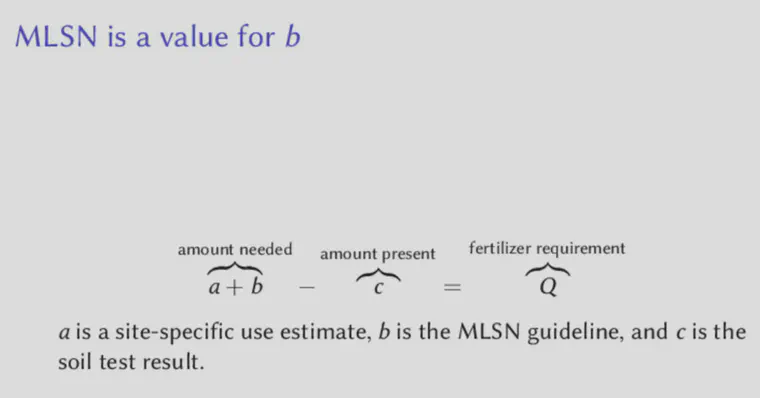An MLSN Refresher
Not everyone understands how the MLSN guidelines work.
I saw a photo shared by Andrew McDaniel followed by a number of replies from STSAsia exhibiting confusion on the latter’s part about the use of the MLSN guidelines.
Taking this year's samples. Still no P or Ca applied for 4 years... or Carbon. #MLSN #keepitsimple pic.twitter.com/rdG4BEjlGO
— Andrew McDaniel (@drumcturf) April 12, 2017
A succinct response to such confusion could paraphrase Brian Ripley: “Once you appreciate that you have seriously misread the guidelines, things will become a lot clearer.”
I’ll take the opportunity here to write a brief refresher about MLSN.
Grass is growing in soil. That soil has a certain amount of nutrients in it. We determine that quantity of nutrients by doing a soil nutrient analysis (a soil test). The amount of nutrients in the soil will change tomorrow, and the next day, and into the future, based on how much we apply as fertilizer, and based on how much the grass uses. But we can use this number. I’m going to call this soil number c. That’s the quantity of a nutrient measured by the soil test.
On its own, that soil test number isn’t useful for anything. I need to compare it to something. How about comparing the amount of a nutrient in the soil to the amount of a nutrient the grass will use? Now I am introducing a time component, because the grass use during 1 month of dormancy is different than the amount of grass use during 1 month of active growth. And the amount of use for 1 day is different than the amount of nutrient use in 1 year. And as STSAsia pointed out, the use is different in different locations. And the use is different for different grasses. Use of the MLSN guidelines explicitly accounts for the expected use of nutrients at any location. Let’s call the expected use by the grass a.
Now we have two quantities. We have a, which is the amount the grass will use. And we have c, which is the amount in the soil. It would seem that this is enough information to determine a fertilizer requirement. We could say if a is more than c, then we definitely need to add the difference, because otherwise the grass will use more than the soil has. And we could say that if a is smaller than c, we don’t need to add that element, because the amount the grass will use is less than the amount in the soil. And that is sort of how it works, but the MLSN guideline adds a buffer of extra nutrients that the grass will never touch.
The MLSN guidelines are added to the amount the grass will use. We can call the MLSN guideline amount b. The amount b is a quantity of nutrients that we always want to remain in the soil, untouched by the grass. So we take a, the amount the grass will use, and add to it b, the amount we want to keep as a reserve in the soil. We then compare a + b to c, and that difference becomes the fertilizer requirement.

With this procedure, the site specific and grass specific and climate specific characteristics of each location are considered, and then an appropriate fertilizer recommendation is made. This fertilizer recommendation for each nutrient is based on how much the grass will use at each site, it accounts for keeping a reserve of nutrients in the soil (the MLSN guideline), and for how much of an element is actually in the soil at the time of sampling.
paceturf made the calculations for nutrient requirements at Fukuoka and Kuala Lumpur. Although the MLSN guideline is the same at each location, the nutrient recommendations will be more than 4 times higher for Kuala Lumpur than Fukuaka.
The MLSN guideline values are the only thing that stays the same. These represent a buffer amount of nutrients in the soil that we don’t want the grass to use. Then the site specific values for estimated grass use of each element, and for the actual soil test at that site, make the MLSN approach suitable for just about every environment.